Let’s be honest for a moment. Zoom lenses are rarely — if ever — able to produce better photographs than their prime lens counterparts.
It’s just natural. Compromises need to be made to capture photographs across a range of focal lengths, and this puts zoom lenses behind the eight ball right off the bat.
But that doesn’t mean zoom lenses produce poor images. If anything, photographs are so close in quality that the added benefit of shooting across many focal lengths with one lens often outweighs the compromises in speed and depth of field. Zoom lenses still have their purpose, no matter the situation or the camera system of choice.
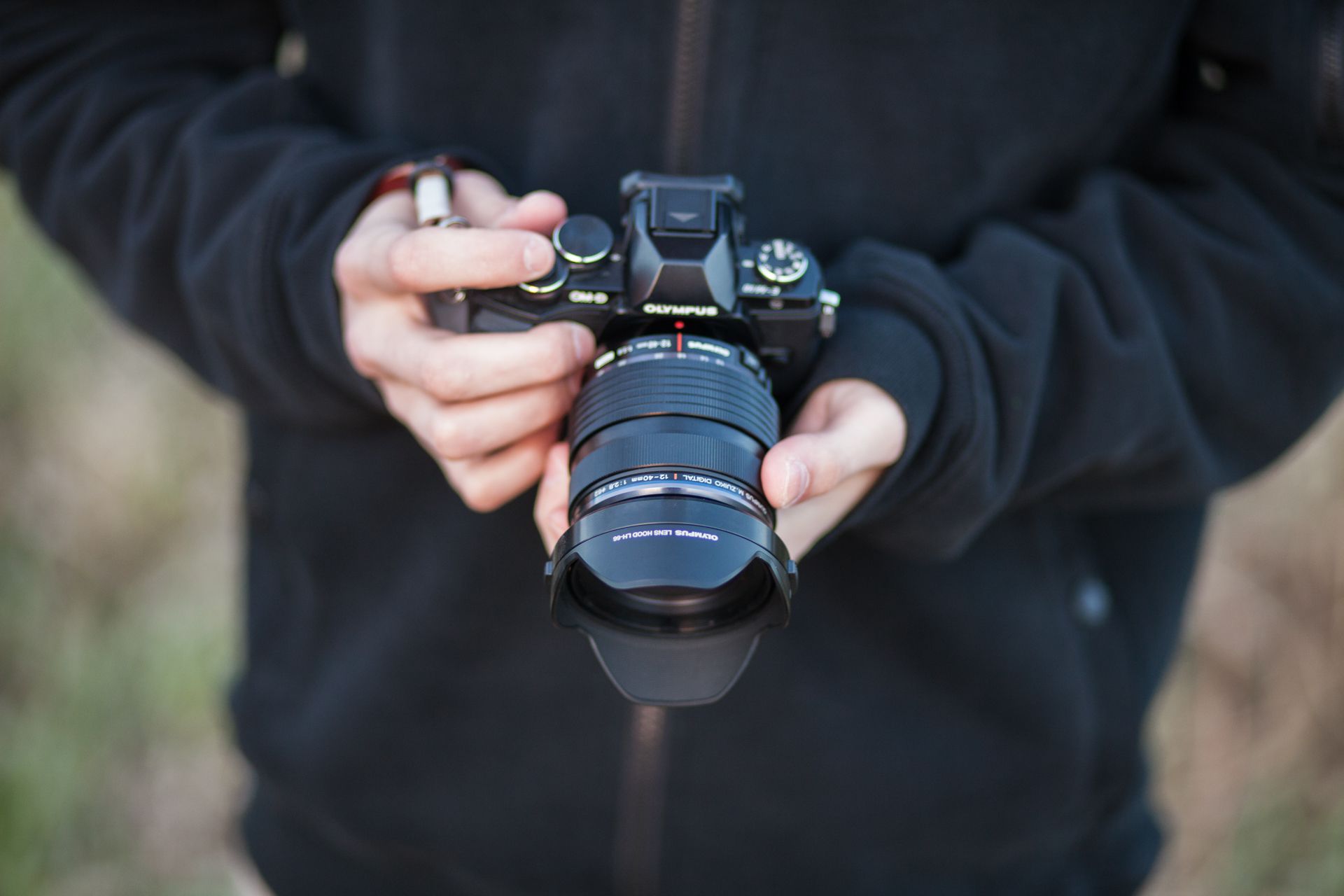
The Olympus 12-40mm f/2.8 Pro lens attached to the Olympus OM-D E-M10.
The Micro 4/3 system in general is known for its small camera bodies and its high quality prime lenses. Lenses such as the Olympus 75mm f/1.8, the Panasonic Lumix 20mm f/1.4, and the Panasonic Nocticron 42.5mm f/1.4 embody the small, light, and fast reputation of the Micro 4/3 system.
Free Photography Guide: Download our Better than iPhone Photography guide to help you get started with you photo skills and camera basics. Along with our gear recommendations for getting started. Get it here.
So why would Olympus set its sights on creating professional level zooms?

The Olympus 12-40mm f/2.8 Pro is a great everyday lens that rarely leaves my camera’s mount.
I think I figured out why during a photoshoot with my sister in January. Capturing a beautiful photograph is far less about how blurry the background gets than it is about capturing the moment. If you’re busy switching your prime lenses because you want the best technical photograph, you’re going to miss your shot nine times out of ten.
That’s why zoom lenses exist. That’s why they exist in every system.

And that’s why I decided I needed a zoom. I missed my shots that day in January. I got some great shots, to the point where my sister was very happy. But I got lucky — it was a beautiful day, there was no one around, I wasn’t getting paid, and the subjects were looking spectacular. It’s hard to mess up that situation. Either way, the number of missed shots from that day left a burning desire to grab a zoom lens.
Choosing a zoom lens in the Micro 4/3 system is actually fairly simple, mostly because there aren’t many great choices. Panasonic has produced some fantastic zooms, such as the Lumix G X Vario 12-35mm f/2.8, the Lumix G X Vario 35-100mm f/2.8, and the Lumix G Vario 7-14mm f/4.0. Each lens covers the effective focal length of the classic full-frame zoom lengths: 14-24mm, 24-70mm, and 70-200mm. Other than these three options, and the two options from Olympus, your choices are limited.
If you’re shooting an Olympus camera body, it makes most sense to attach an Olympus lens to it. If the lenses are the same price, and if you’re not looking for anything specific which only one manufacturer produces, the Olympus lens is your best bet.
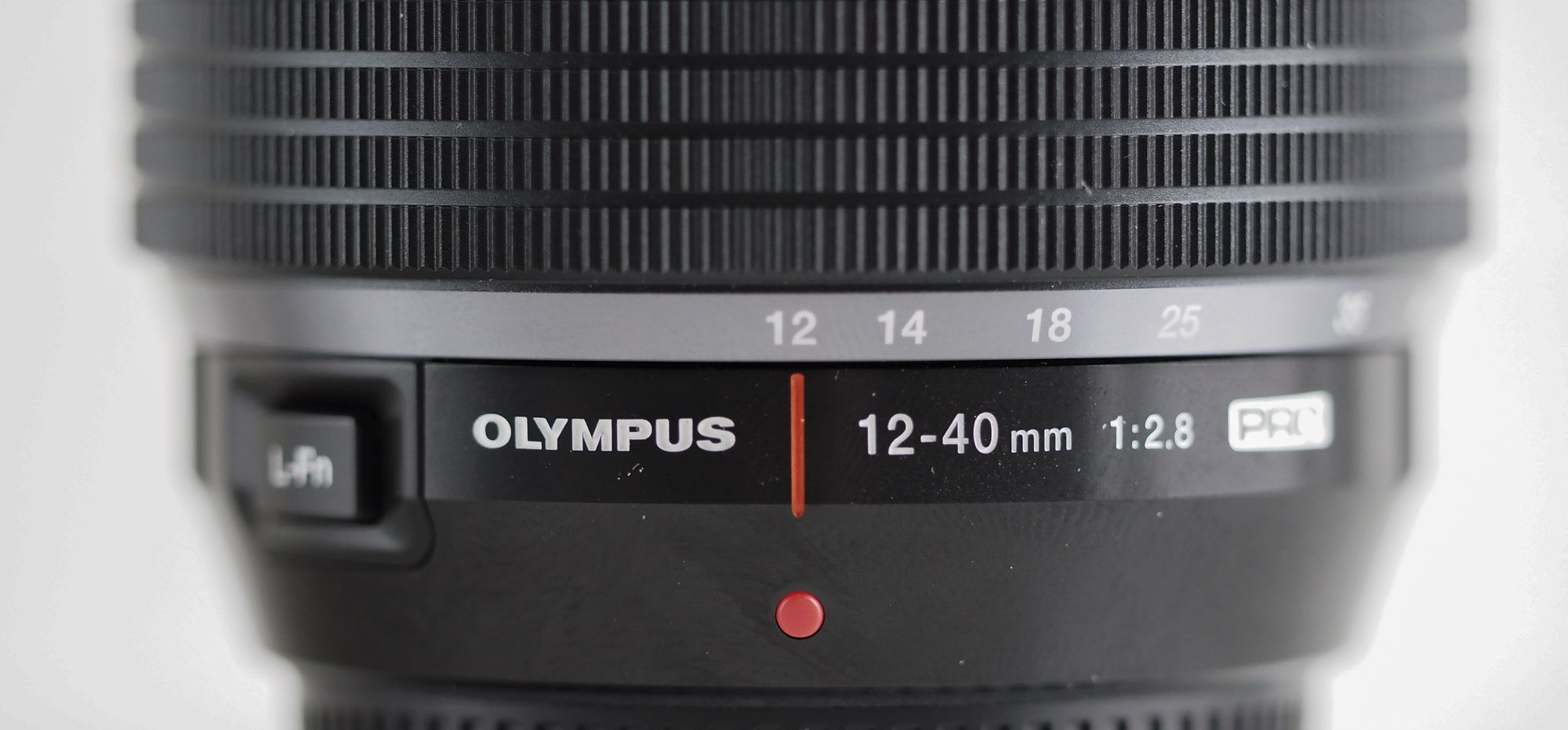
So I grabbed the $999 Olympus 12-40mm f/2.8 Pro lens. The 12-40mm is the first zoom lens in Olympus’ Pro line of lenses and was launched alongside the Olympus OM-D E-M1 mirrorless camera body in 2013. It’s a large lens (in comparison to other lenses in the Micro 4/3 system) but its build quality, sharpness, and overall image quality more than make up for its size and speed.
Some Specifications
The Olympus 12-40mm f/2.8 Pro is the first lens produced for Olympus’ professional line of zooms. The lens sits in the 24-80mm full-frame focal length range, one of the most sought after focal ranges in the business.
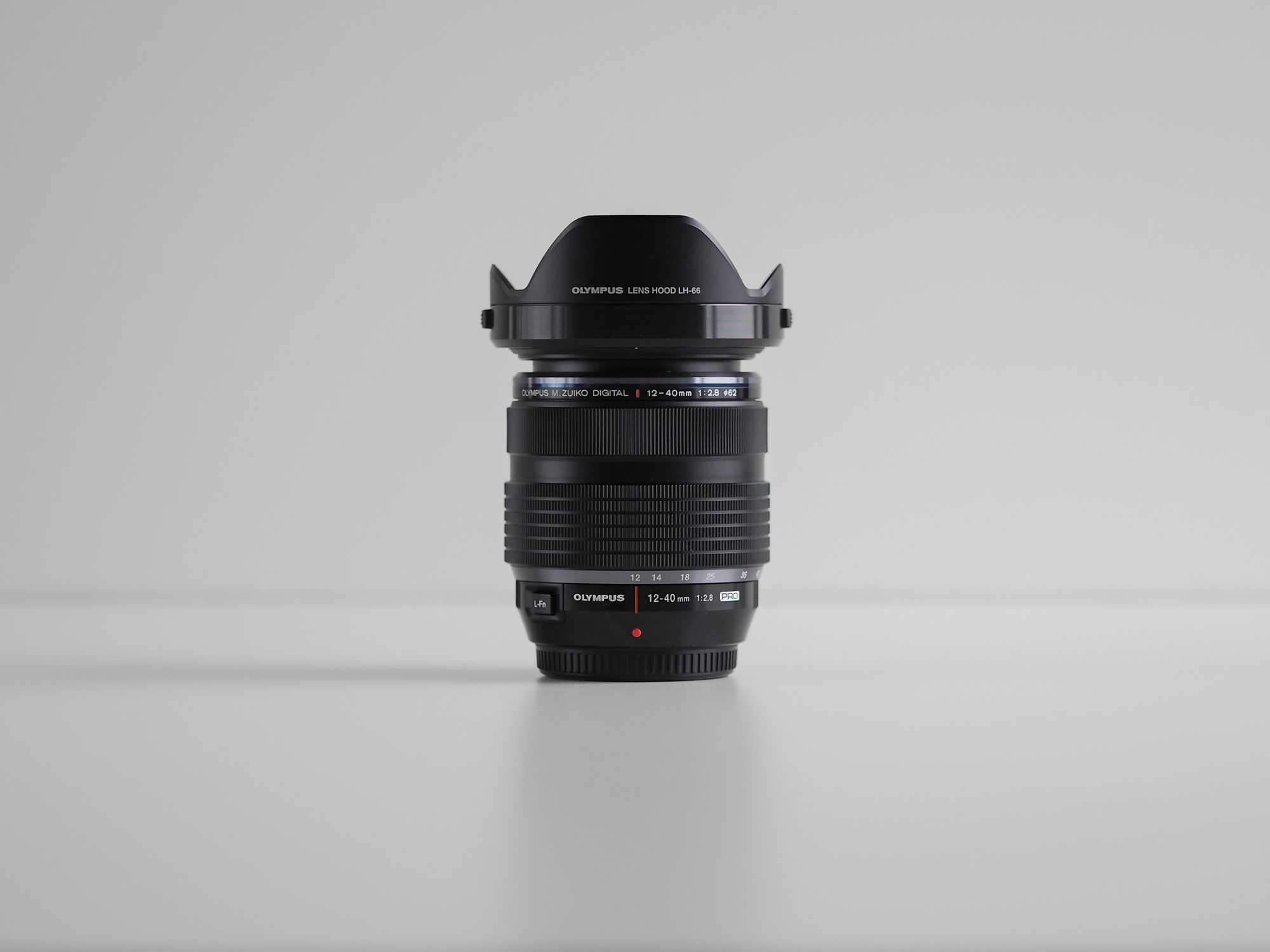
The side profile of the 12-40mm f/2.8 Pro shows its ergonomic design and handy features.
The f/2.8 aperture size matches the full-frame speed of Nikon’s “Holy Trinity lenses“. In terms of gathering light and increasing shutter speeds, the 12-40mm does a fantastic job. However, due to the Micro 4/3 sensor size, depth of field of the 12-40mm f/2.8 Pro lens doesn’t match its full-frame f/2.8 counterparts. Backgrounds don’t get as blurry as those captured by a full-frame lens with the same aperture.

With the lens hood removed, the 12-40mm f/2.8 Pro fits in the palm of your hand.
But hey, you don’t purchase a Micro 4/3 system to blow out your backgrounds — you buy it because it’s small and light. And in terms of size, the 12-40mm f/2.8 is far smaller than any “wedding-style” lenses in any full-frame system. In fact, if you judge the graphic on this page, the 12-40mm f/2.8 may be as little as half the size of equivalent full-frame lenses.
However, in relation to other Micro 4/3 lenses, the 12-40mm is fairly large. It’s slightly larger than the Olympus 75mm f/1.8 and its significantly heavier than any of the small primes you can purchase. So, while tiny in relation to the lenses it’s truly up against, the Olympus 12-40mm f/2.8 Pro is on the beefier side in the Micro 4/3 world.
From the technical side of things, Olympus’ first pro-level zoom is largely affected by its small Micro 4/3 sensor size. Once we get past the sensor effect, the Olympus 12-40mm f/2.8 Pro lens is fairly standard for professionals in this focal range.
Build Quality
The 12-40mm f/2.8 Pro is built as sturdy as any lens or camera I’ve put my hands on. From the front element right through to the metal mount, this lens feels just about bulletproof.
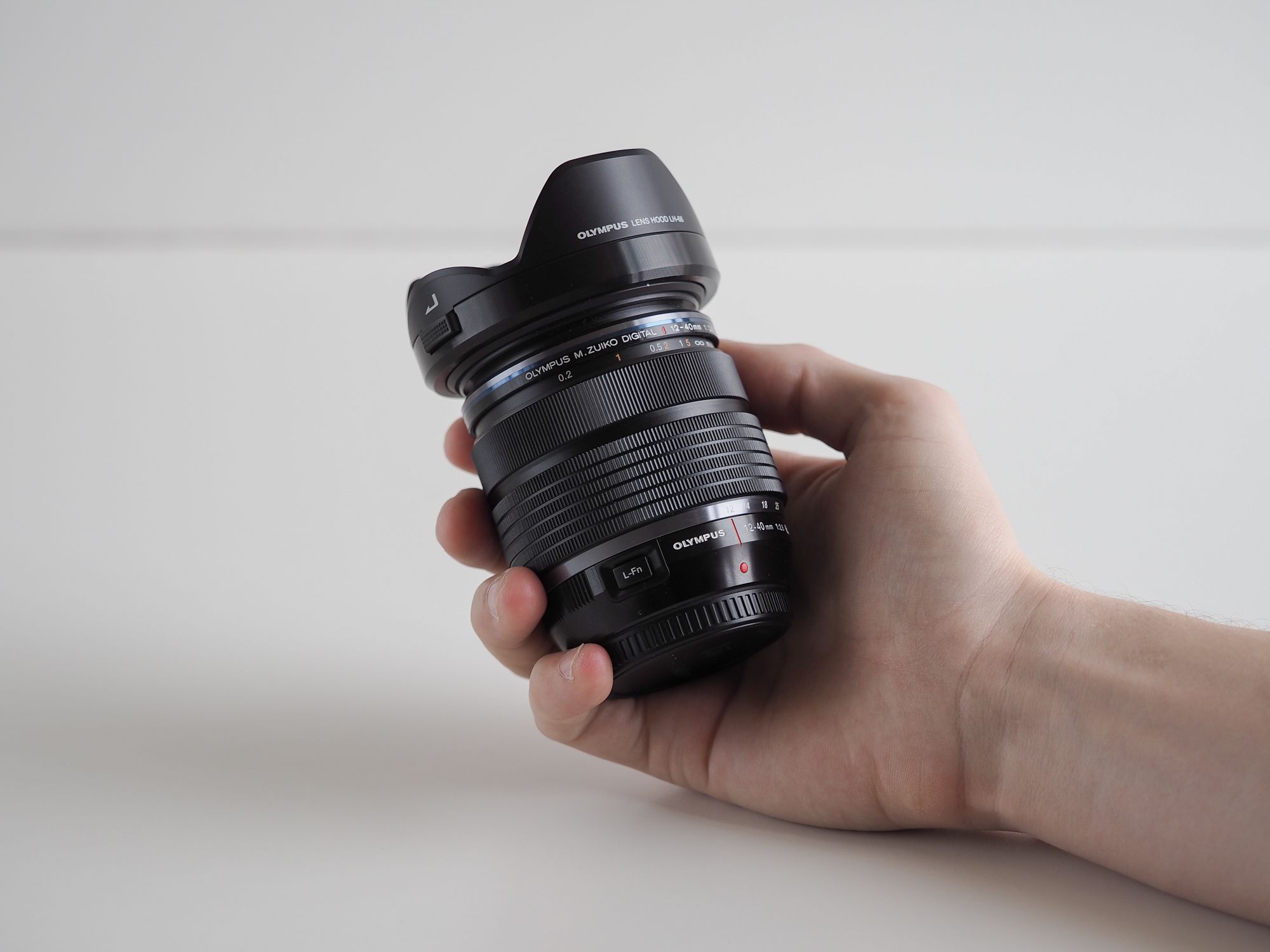
The 12-40mm’s construction is metal throughout, providing a significant heft to the lens. I have the 12-40mm attached to an Olympus OM-D E-M10 and the 12-40mm lens adds some significant bulk to the entire package. When using the 12-40mm with the E-M10, I recommend using the added grip to provide a little more stability. The lens was introduced alongside the larger bodied E-M1, meaning the size of the lens is slightly too large for the E-M10 body. However, adding the extra grip to the E-M10 provides the right amount of extra size for fitting properly in your hand.
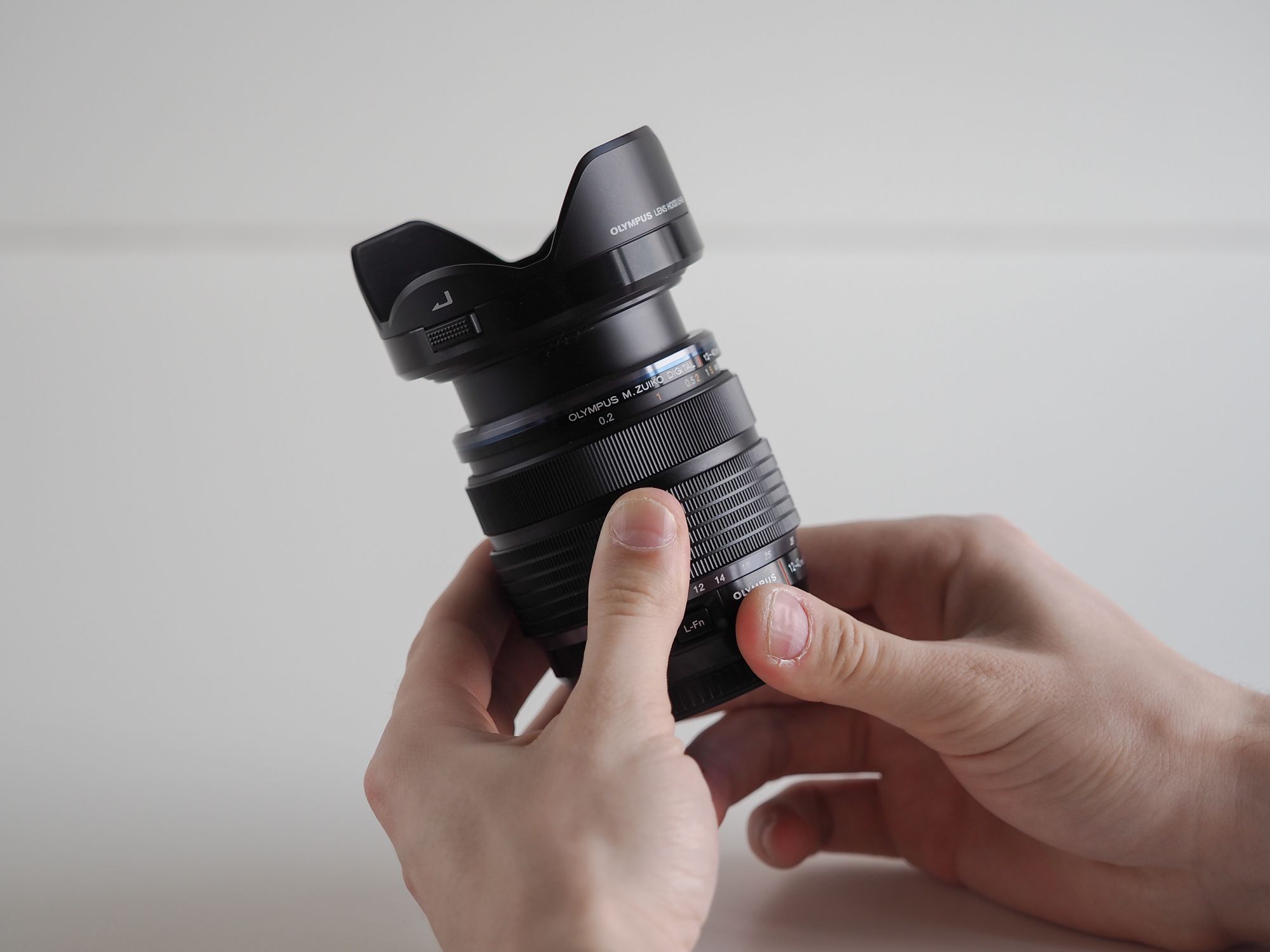
The lens extends as you zoom out to 40mm, which has both positive and negative aspects. The lens stays compact, but less moving parts always means less to worry about.

The lens extends about an inch to an inch and a half outwards, which isn’t nearly as far as other lenses, such as the Olympus 14-150mm f/4.0-5.6 II lens.
The 12-40mm zooms externally by extending the front element outward. When zoomed in on a subject, the lens extends approximately an inch and a half and reveals the lens’ zoom construction.
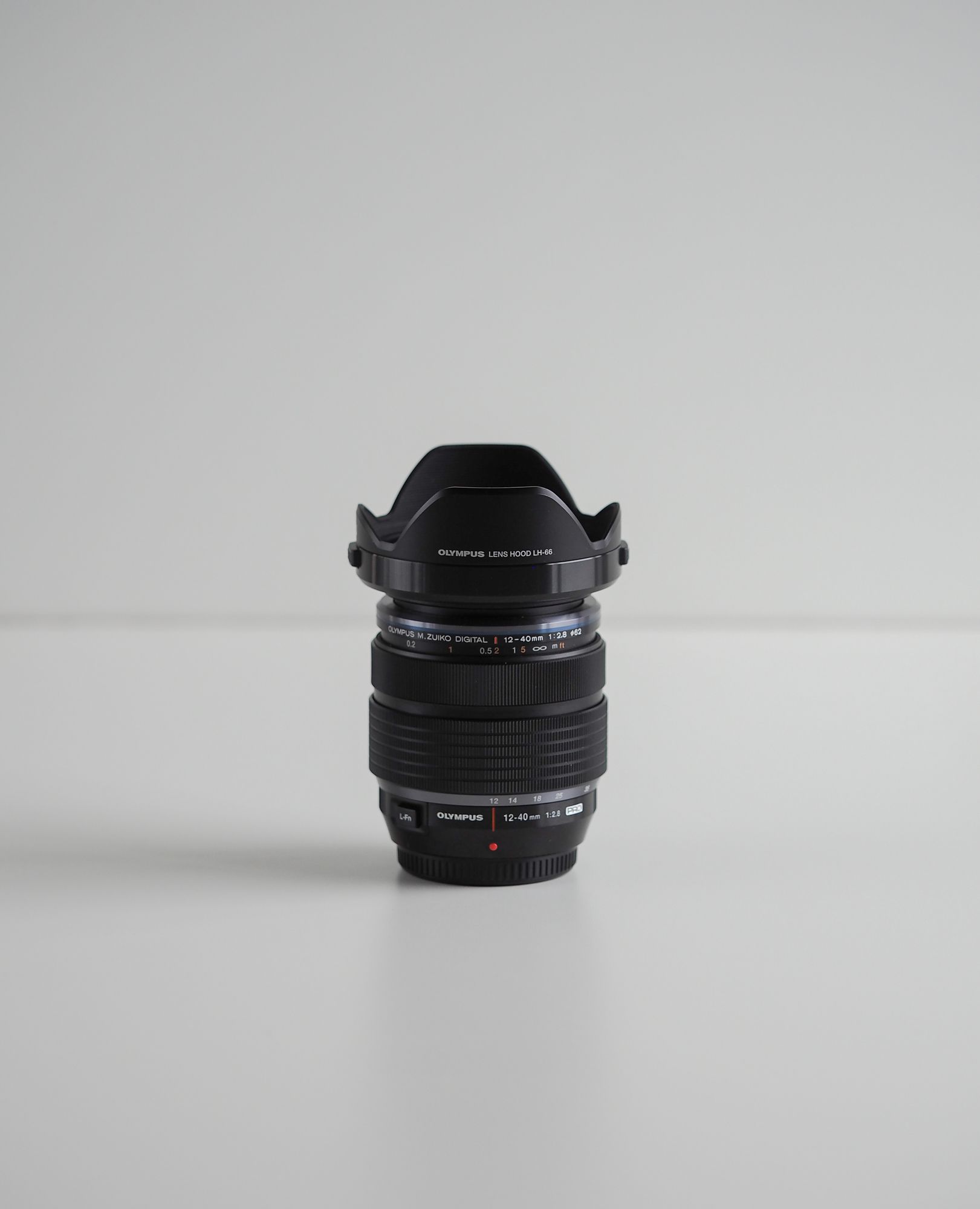
The 12-40mm lens in its compact form.
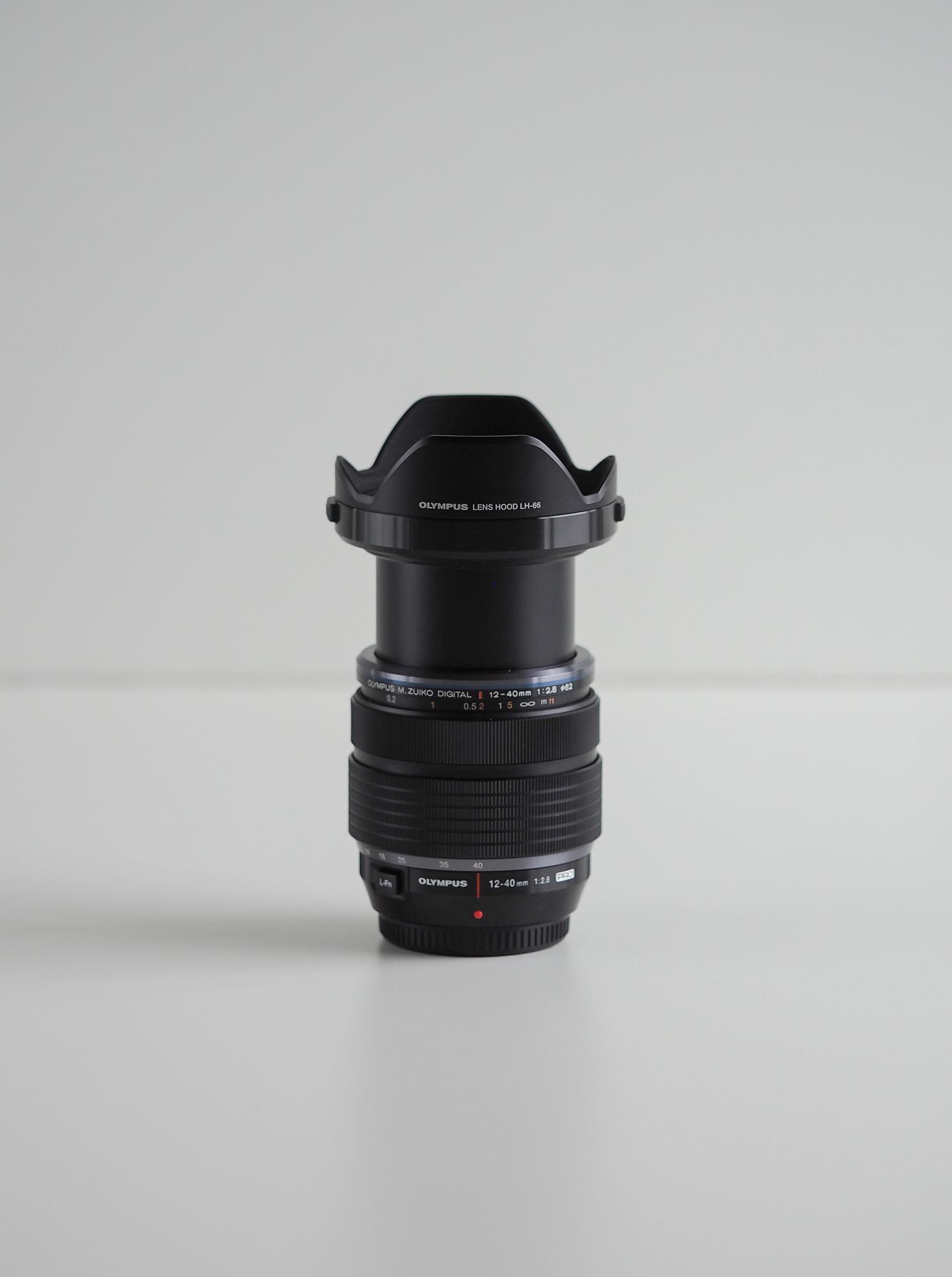
The 12-40mm lens in its extended form.
I always prefer lenses which zoom internally, but I understand the need here to keep the lens more compact. The 12-40mm covers an everyday focal range, so making the sacrifice of an external zoom seems necessary.
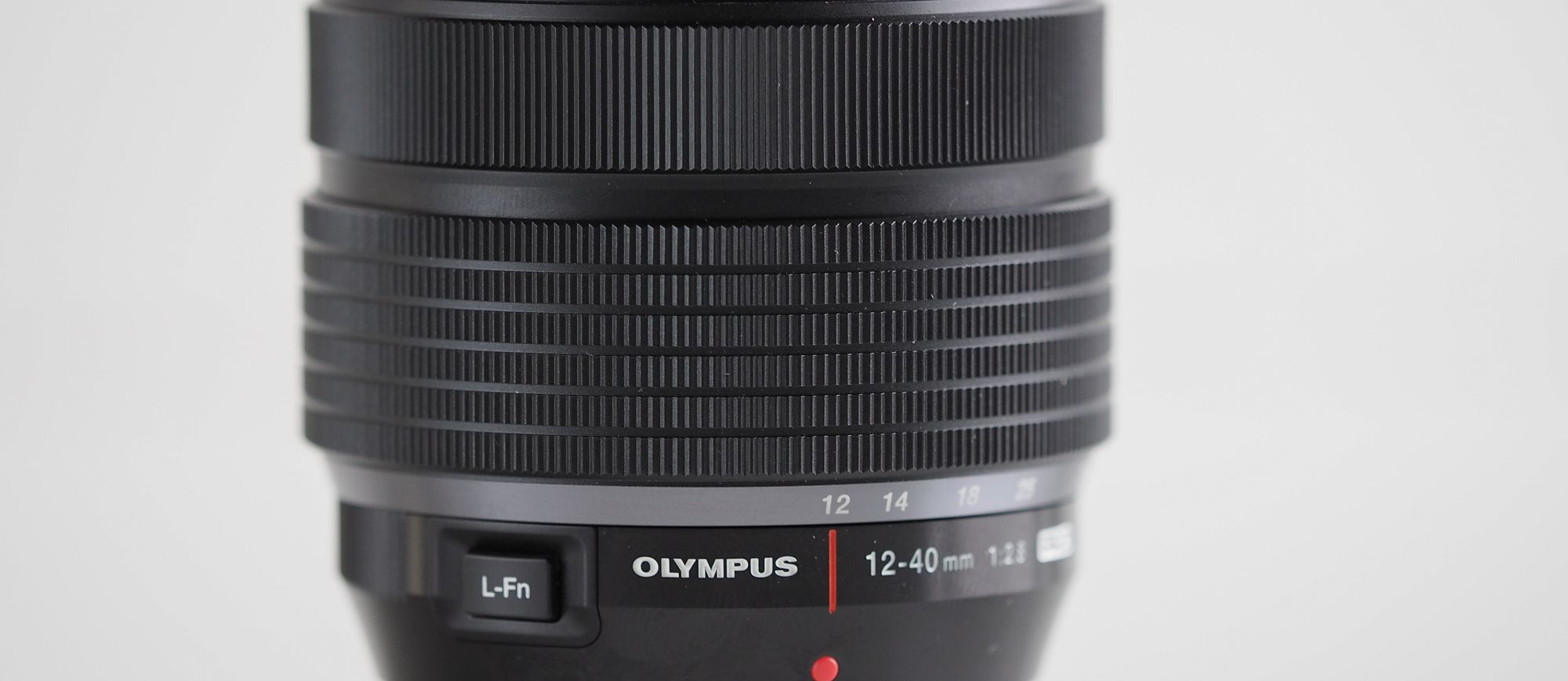
The zoom ring is brilliantly solid and has milled grooves to allow proper handling of the lens.
The zoom ring itself is built solidly and spins with a beautiful amount of friction. Very fine grooves in the zoom ring provide the right amount of tactility with your fingers, allowing a proper grip even under sub-optimal conditions. The ring’s friction also eliminates accidental movements when you’re focused on a subject or when you’re roughing it out in the terrain. Lenses like Nikon’s 18-200mm VR were notorious for zoom creep when moving around because of an improperly tuned zoom ring. There are no issues with zoom creep in the Olympus camp.
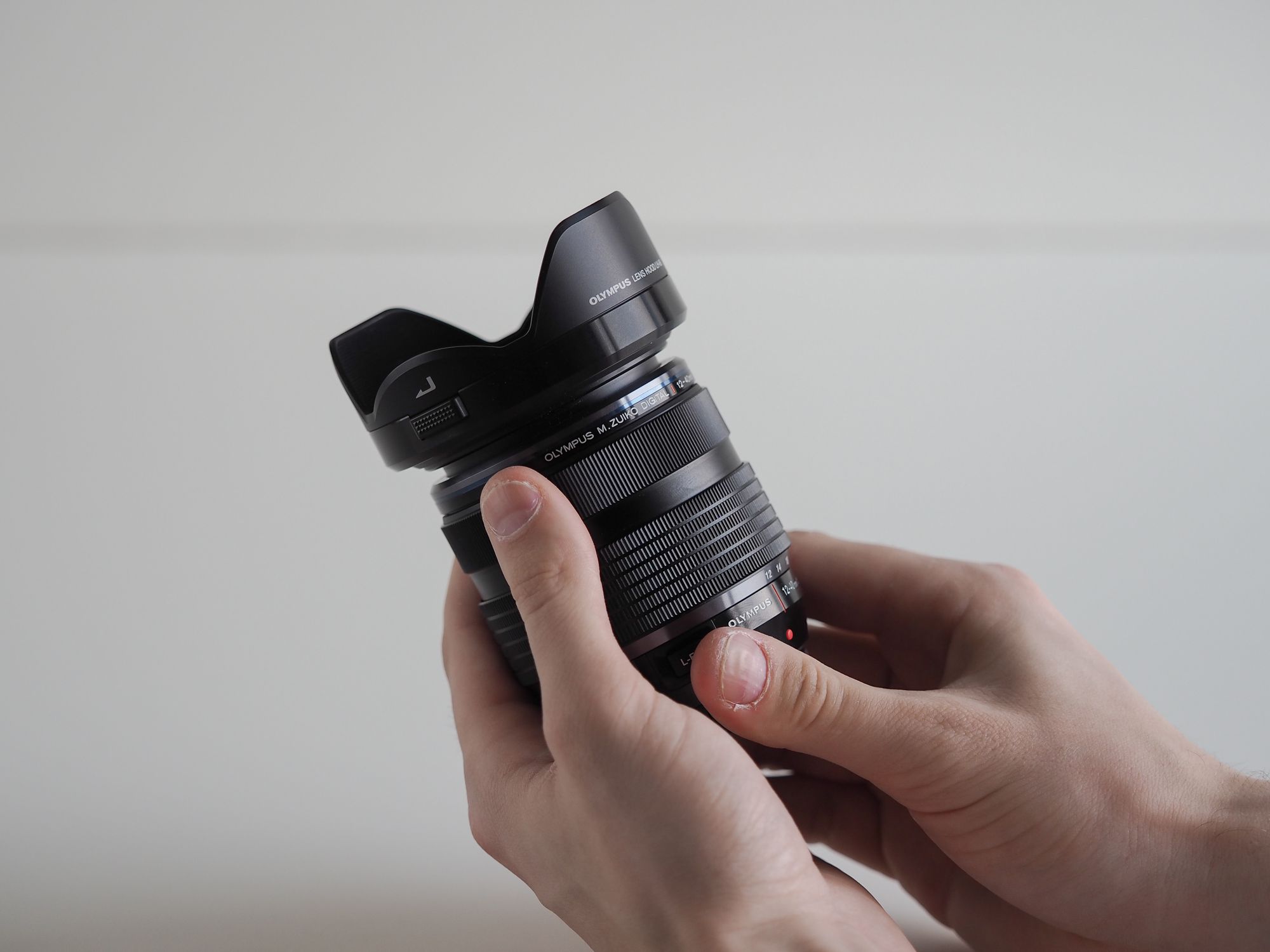
Olympus’ world renowned manual focus clutch works superbly. Just pull back the manual focus ring to snap the camera into manual focus mode. Push it forward and switch to back to autofocus. Once I experienced this great clutch, I was ruined for any other lens without it.
Further to the front of the lens is Olympus’ highly regarded manual focus ring. Olympus first introduced the manual focus clutch in the 12mm f/2.0 prime lens and has since implemented the technology across a wide array of lenses. When the clutch is pushed forward, the 12-40mm snaps to a subject in the blink of an eye on its own. When pulled back, the lens automatically switches to manual focus for perfect precision. Instead of needing to program a special function button to switch from auto focus to manual focus, the placement of the clutch mechanism behind the zoom ring feels natural and perfectly placed.
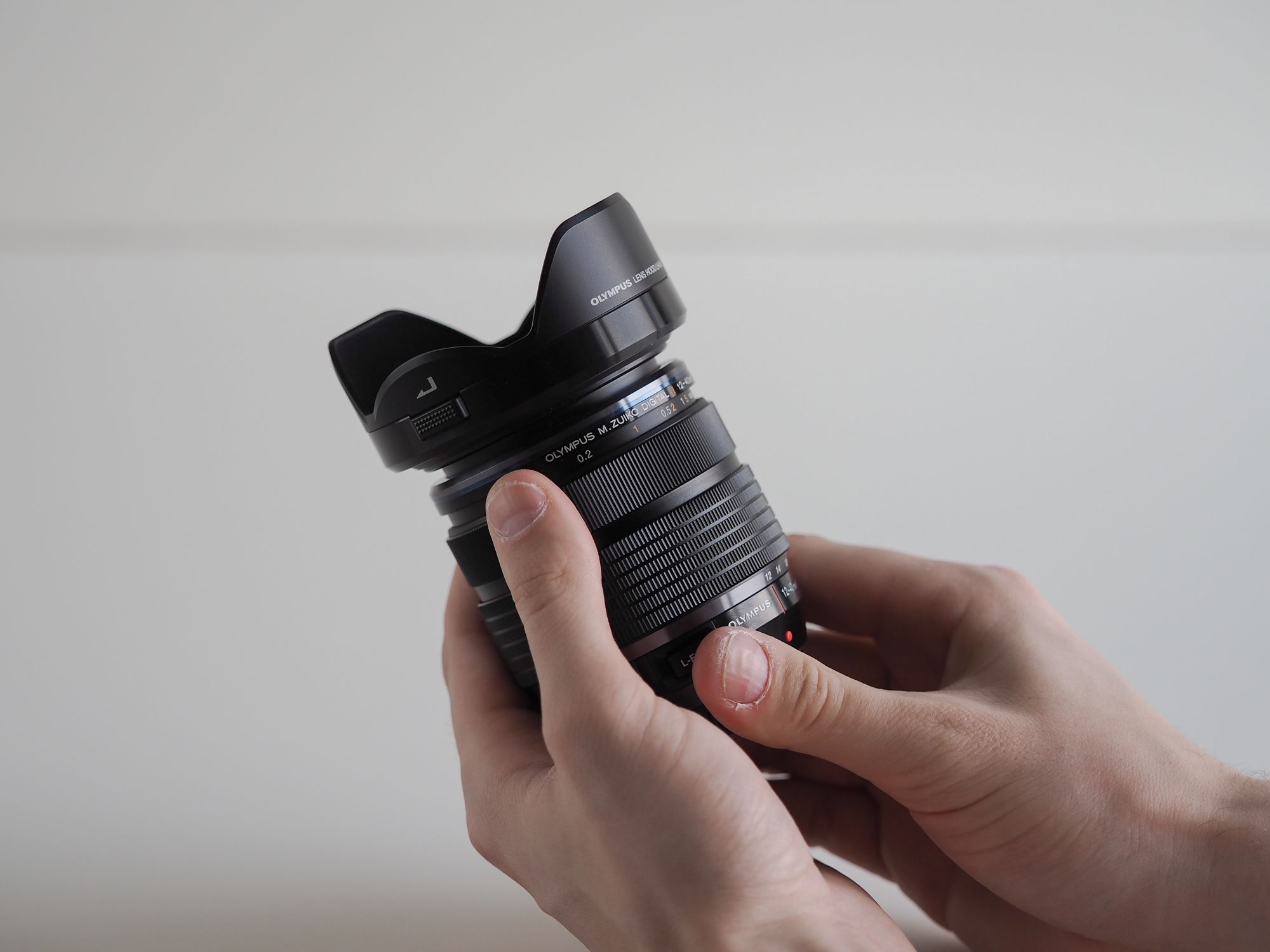
Pulling back the clutch reveals the scale to help gauge where in the viewfinder you are focused.
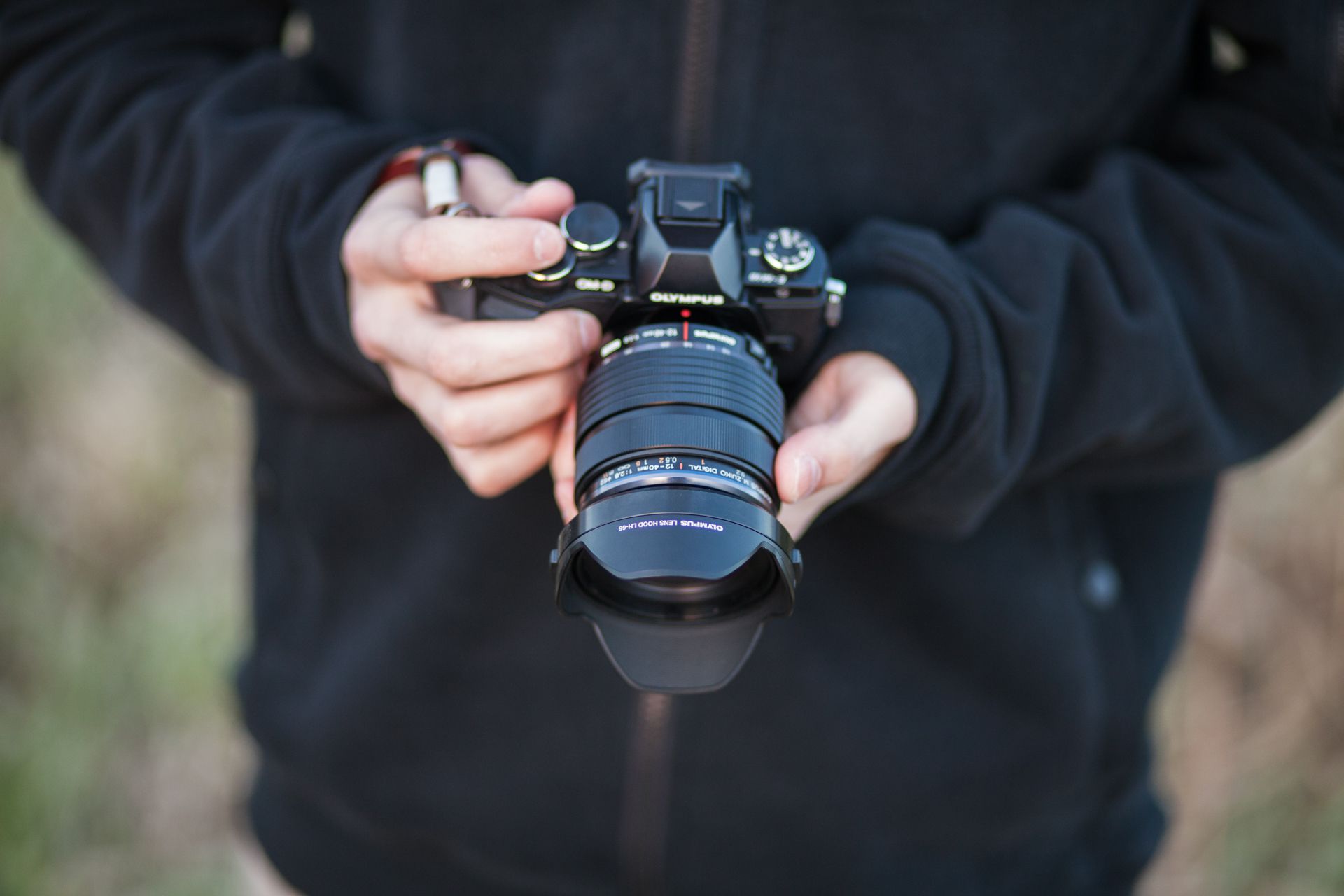
The manual focus ring has hard stops at 0.2m and infinity. This eliminates extra spinning to find out where you are in the frame. Combine this feature with focus peaking and manual focus becomes a fast method of shooting with precise focus.
When pulled back, the zoom ring reveals a scale to gauge where the lens is focused. When cranked all the way to the left, the lens is focused at a point approximately 20 centimeters in front of the lens. When twisted to the right, the lens focuses to infinity. But most importantly, this manual focus ring hard stops at 0.2 meters and infinity. The 12-40mm’s manual focus ring stops eliminate endless spinning to figure out where the lens is focused. This was one of my biggest complaints with the Olympus 75mm’s manual focus ring. Not only is the 12-40mm’s zoom ring of higher build quality, it also implements hard stops to eliminate unnecessary fiddling.
Olympus includes an extra function button on all its Pro lenses. The function button is placed in a nice spot where your thumb will often rest and it depresses comfortably and with proper intention. The button is a bit squishier in comparison to the other buttons on the E-M10 camera body, but this is reflective of the lens’ weather proofing qualities and not the button’s quality. The squishier button will feel right at home on weather proofed Olympus bodies like the E-M5, E-M5 Mark II, and E-M1. However, on the E-M10, the button serves to remind me my camera body isn’t weather proofed.

All of Olympus’ Pro lenses are weather proofed, meaning you can take this lens into a rougher terrain and not worry about ruining your kit.
Of course, any lens worthy of the “Pro” title must carry with it weather proofing characteristics. The 12-40mm is dustproof, splashproof, and freezeproof to complete the weather proofed package for all of Olympus’ top end OM-D camera bodies. Many people may not worry too much about the lens’ weather proofing, but I have run into countless moments where I have been afraid of heading outside to shoot some photos. Our super cold Manitoba winters also make weather proofing a viable characteristic to consider when purchasing. Now that I have weather proofed lenses in my kit, the next camera body I purchase will surely share the ability to head out into the outdoors with no concern for the weather man.
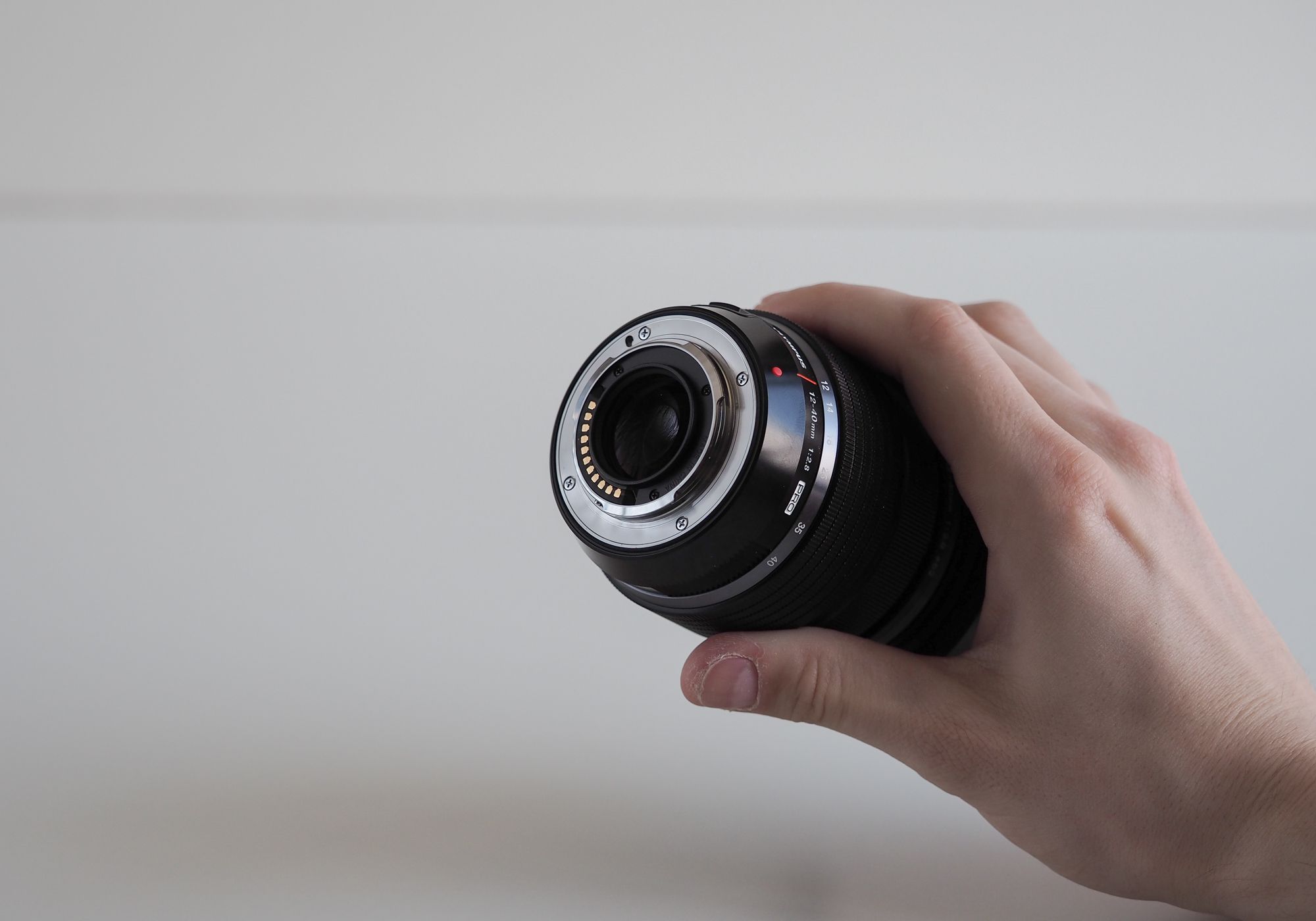
The mount is made of solid metal, greatly diminishing the chance of breaking the lens at the mount end.
The 12-40mm f/2.8 Pro’s mount is made of solid metal to complete the high quality construction. The size of the lens may warrant picking up your camera/lens package from the lens instead of the camera body, and you can be sure the lens won’t break in your hand as you pick it up.
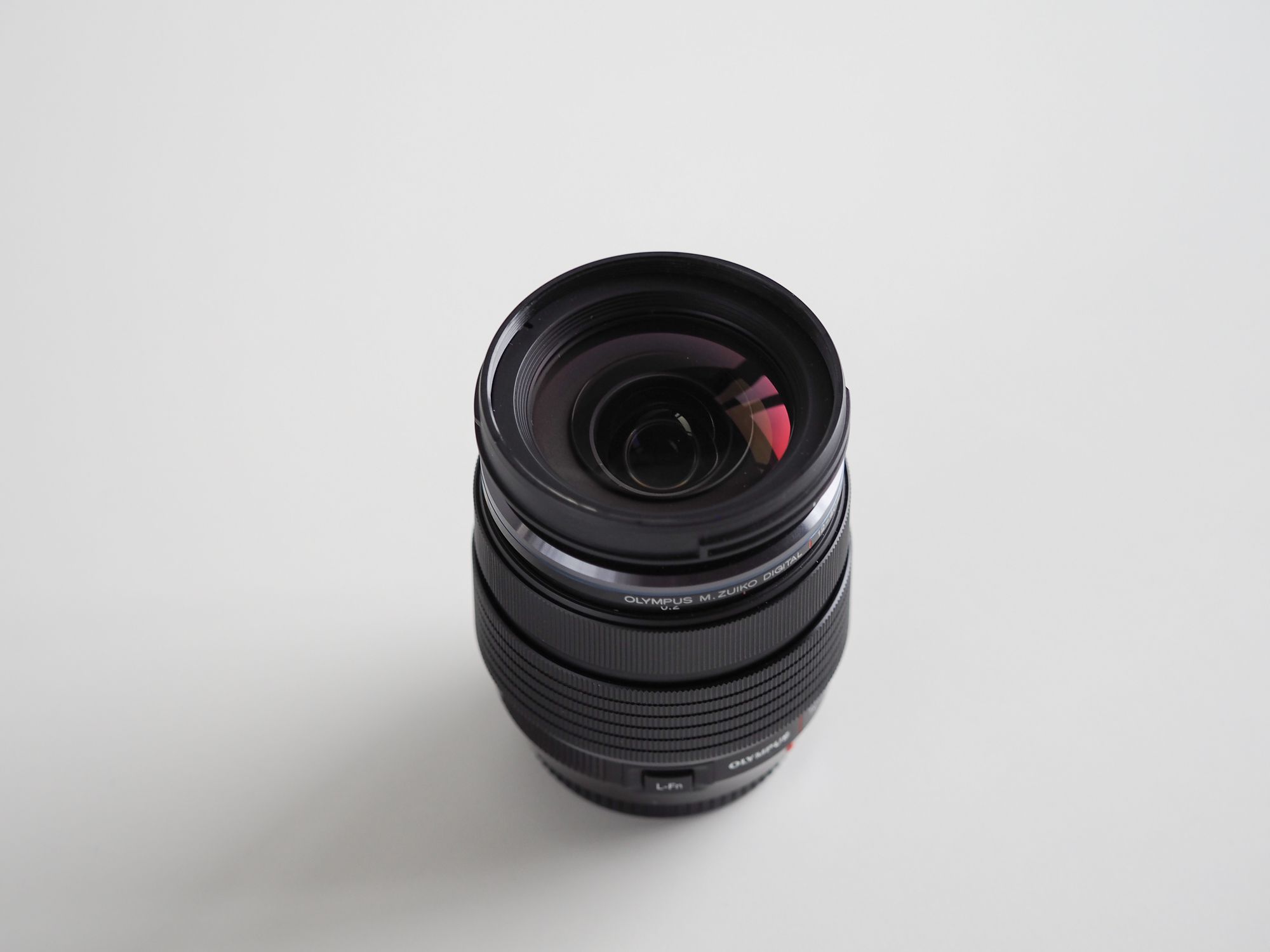
The large 62mm filter doesn’t rotate when zooming, allowing circular polarizers to be quickly used and adjusted.
The front element of the 12-40mm is 62mm in diameter, which is actually quite large for a Micro 4/3 lens. Olympus sells filters designed specifically for the 12-40mm front element which eliminate direct scratches on the lens. I, however, have chosen to purchase a 62mm circular polarizer to eliminate large amounts of glare and to help properly expose photos on bright summer days. The 12-40mm’s front element doesn’t spin when zoomed, so placing the circular polarizer at the right spot when zooming in and out on a subject is possible without too much fidgeting.
Lastly, included with the 12-40mm f/2.8 Pro are a few accessories. Olympus includes these accessories alongside their Pro lenses and sells them separately for their Premium lenses. Although not a large part of the overall package, the quality of the accessories should be noted when you swipe your credit card.
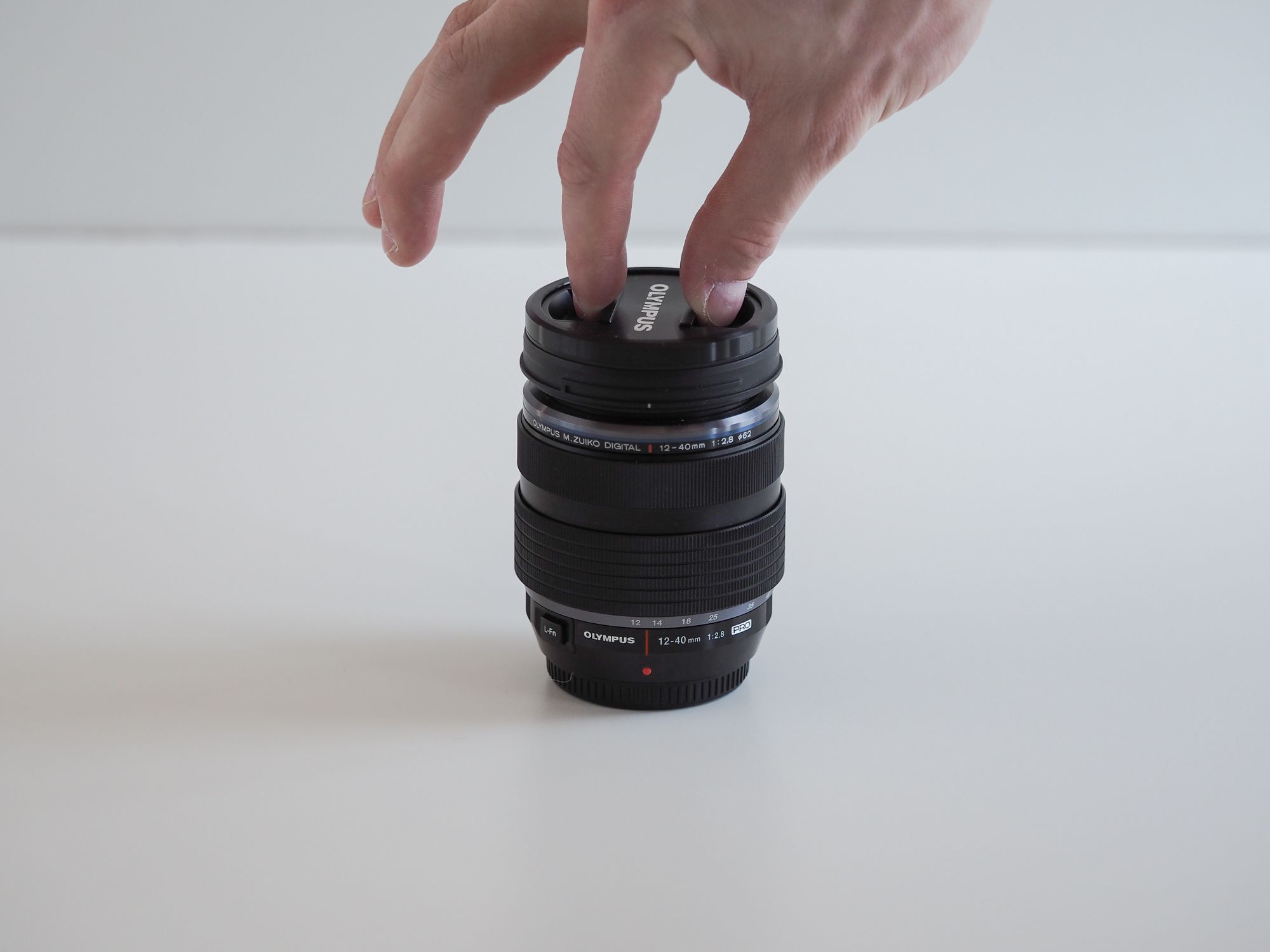
Even the accessories in this lens package are made of the highest quality material. The lens cap is made of high quality plastic and is durable enough to ensure your front element won’t be scratched without a fight.
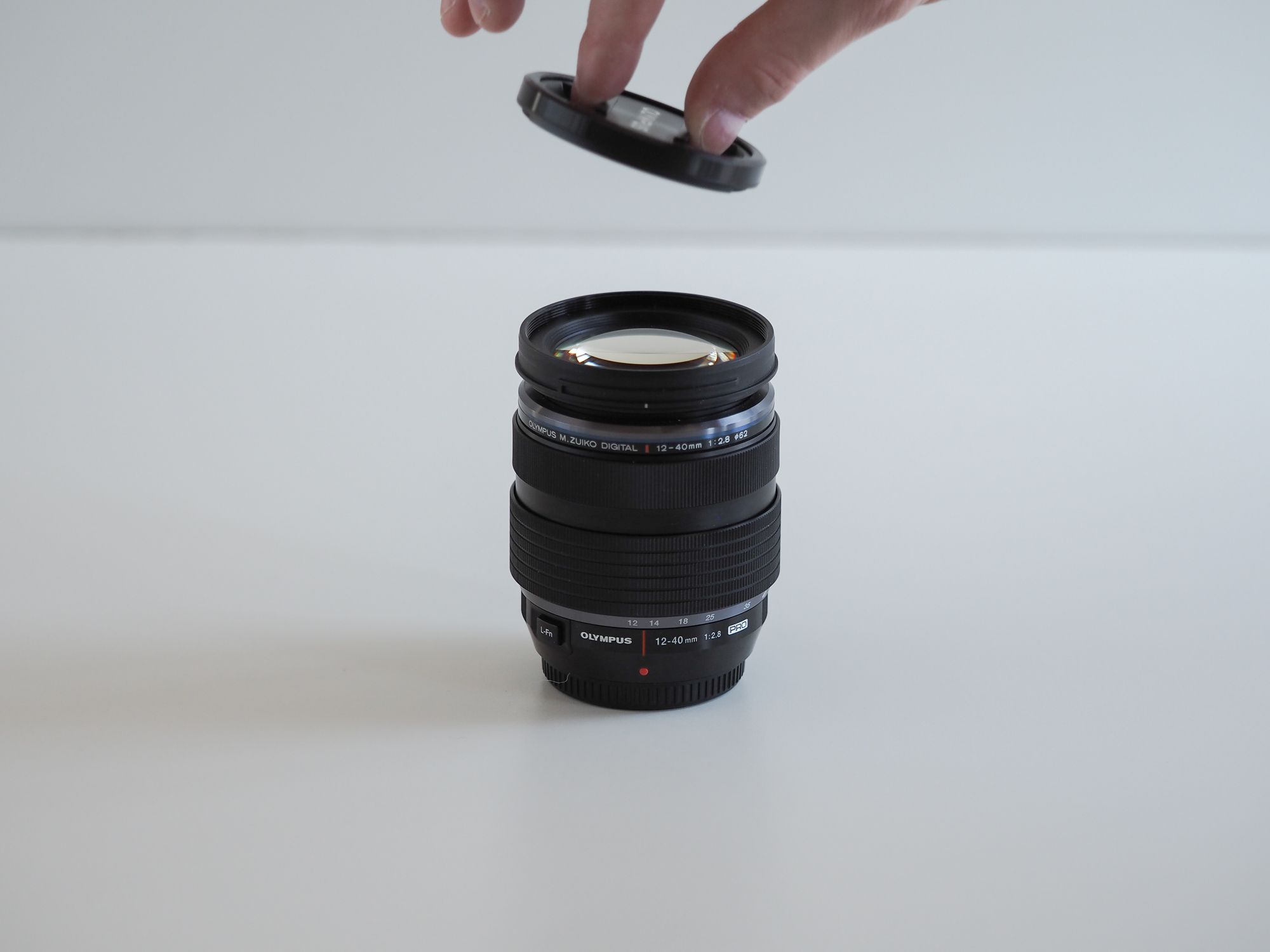
The lens cap is removed and snapped into place simply by two slots on the front of the lens cap.
The 12-40mm’s front element lens cap is of the highest quality. The Olympus letters are precisely milled on the front of the lens cap and give it a nice shine in the right light. The lens cap doesn’t feel like metal, but it feels like the highest quality plastic I could ask for.
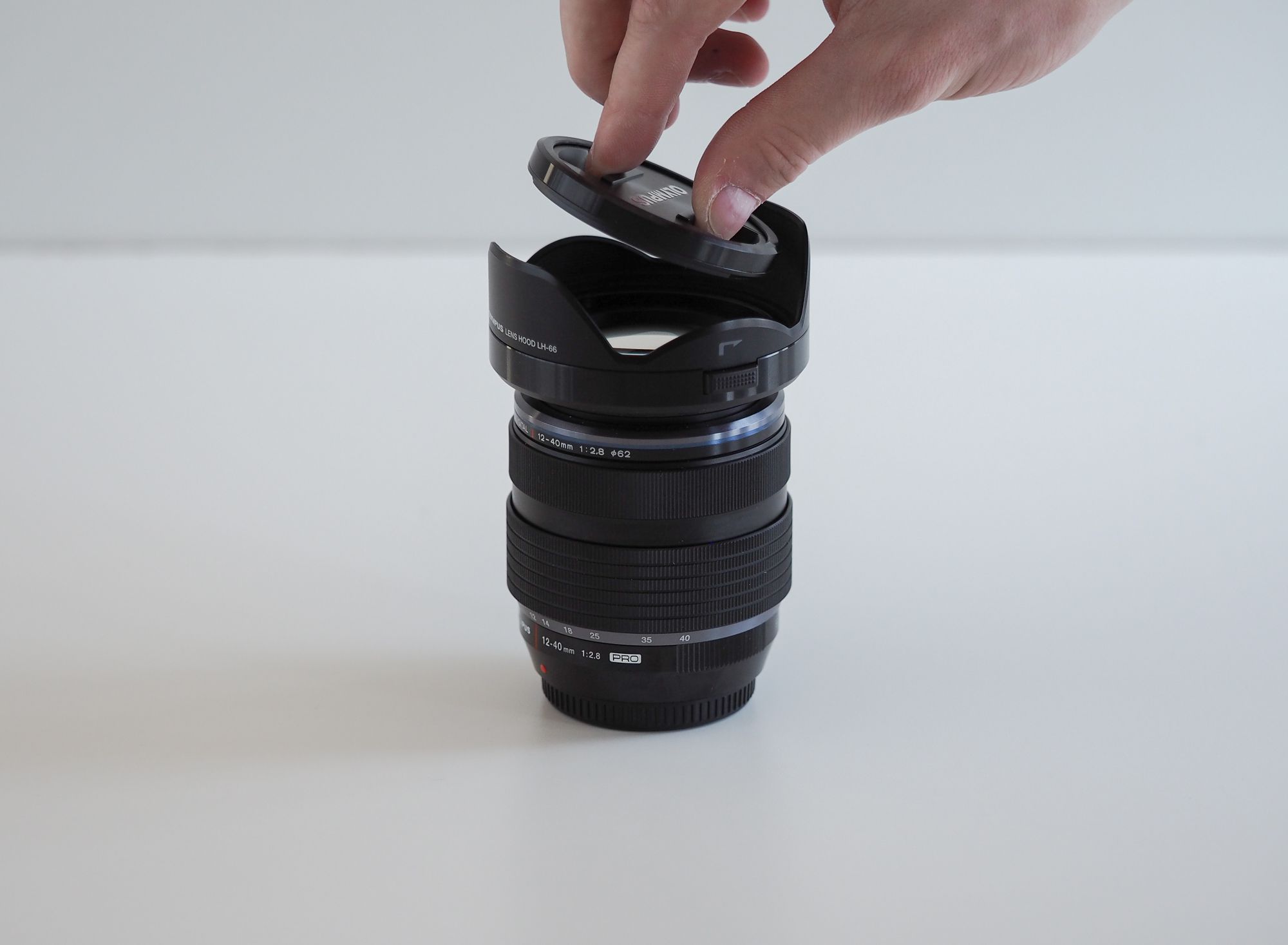
If the lens cap was removed by two slots on the outside of the cap, it would be impossible to remove the lens cap with the lens hood attached. Olympus has thought about everything with this lens package.
The lens cap pops off via compressing the two slots on the front of cap. This seems like a misnomer, but when the 12-40mm’s lens hood is attached, removing the lens cap can be problematic if it is removed via slots on the outside edge of the cap. Instead, removing the cap is as simple as a pinch, with or without the lens hood attached.
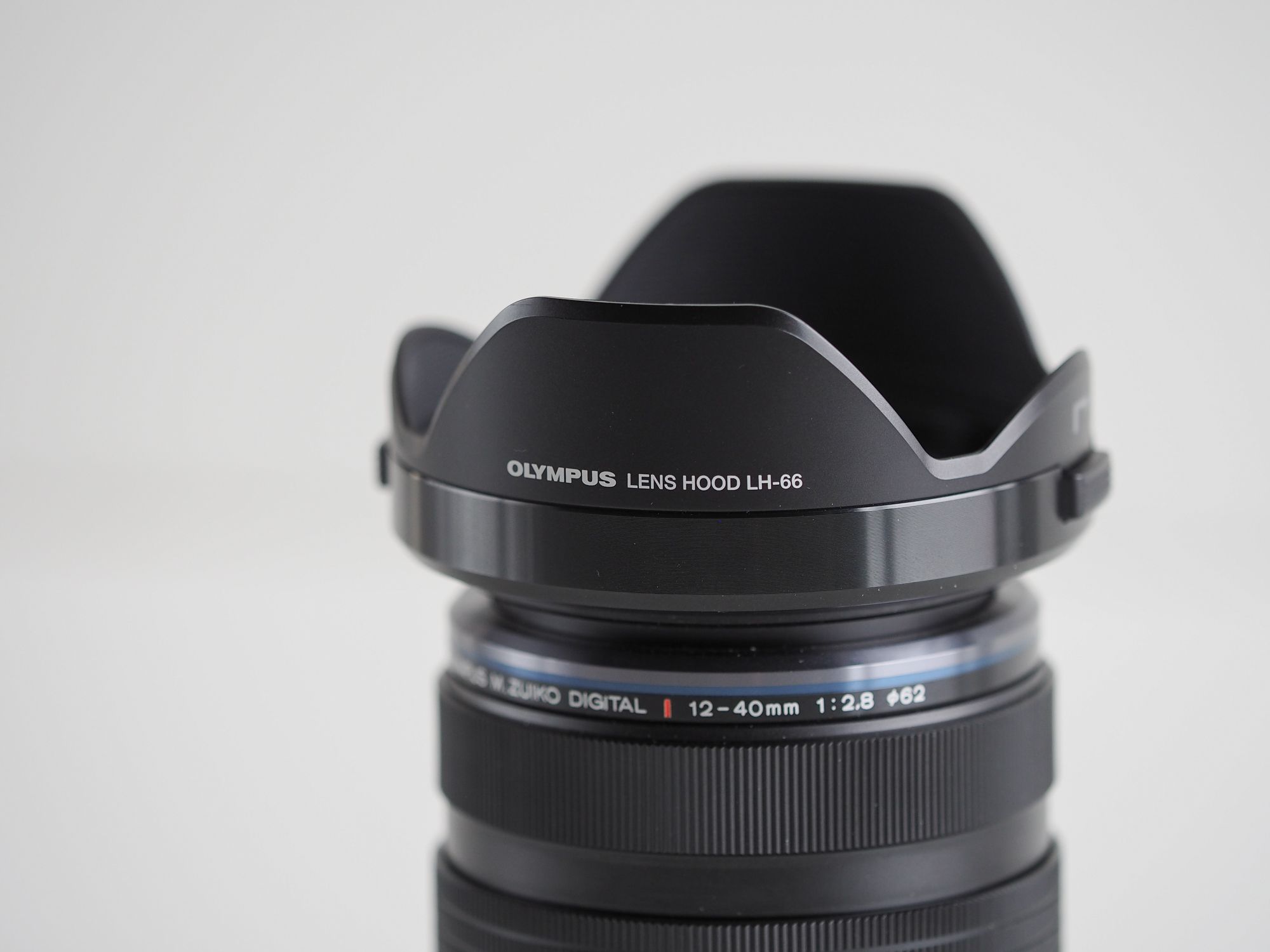
The lens hood is attached and removed by two buttons on the outside of the hood.
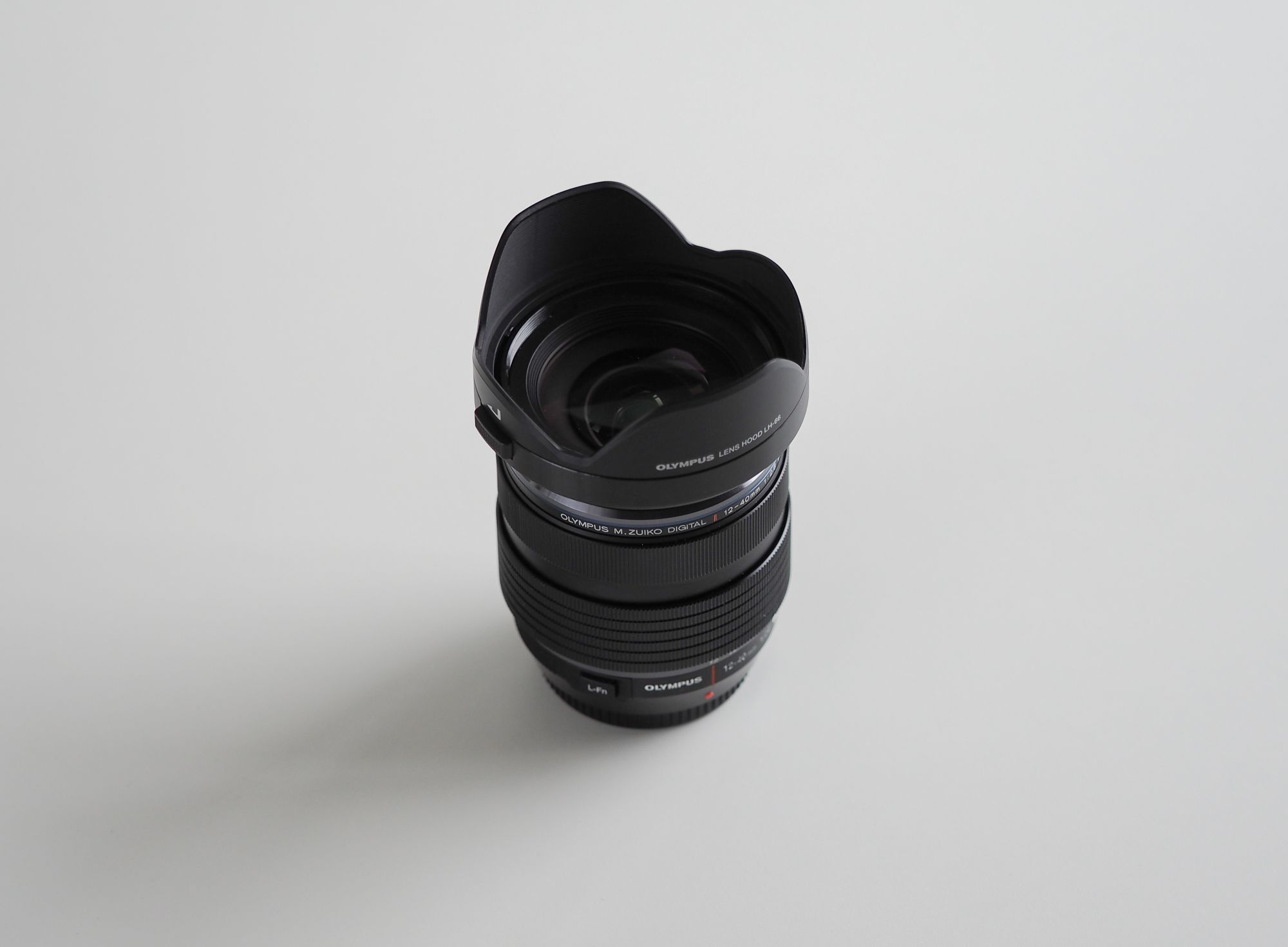
Like the lens cap, the lens hood is made of a high quality plastic and is great for eliminating unnecessary light and for unnecessary attacks on your front element.
The 12-40mm’s included lens hood is also no slouch. Again, although not made of metal, the lens hood is sturdy and snaps into place firmly on the front of the lens. I prefer the aesthetic of the lens without the lens hood, but it’s hard to deny the impact a lens hood can have in your images.
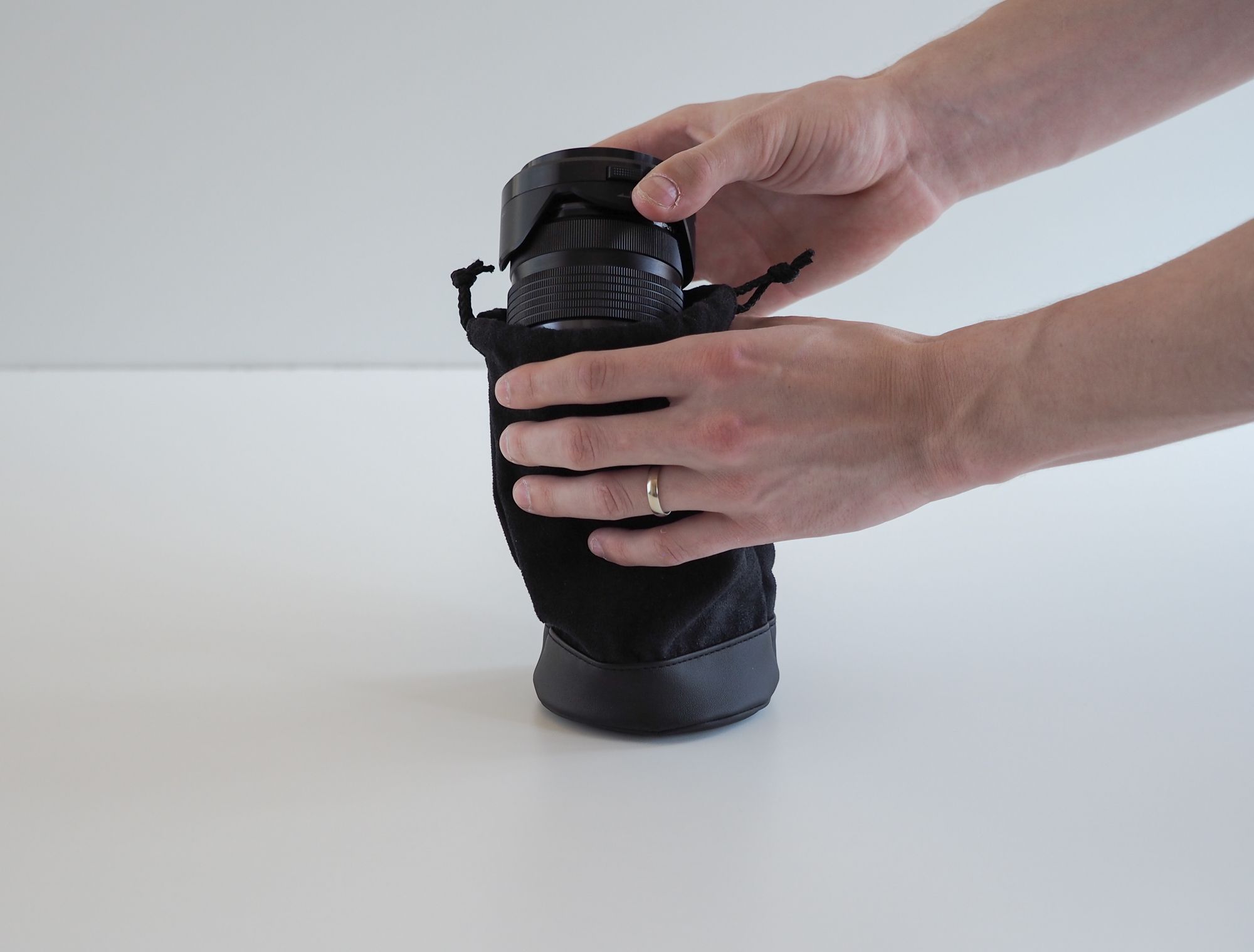
The Olympus 12-40mm f/2.8 Pro comes with a supple carrying bag with a nice synthetic leather base. This leather base keeps the bag clean when pulling out the bag in the outdoors.
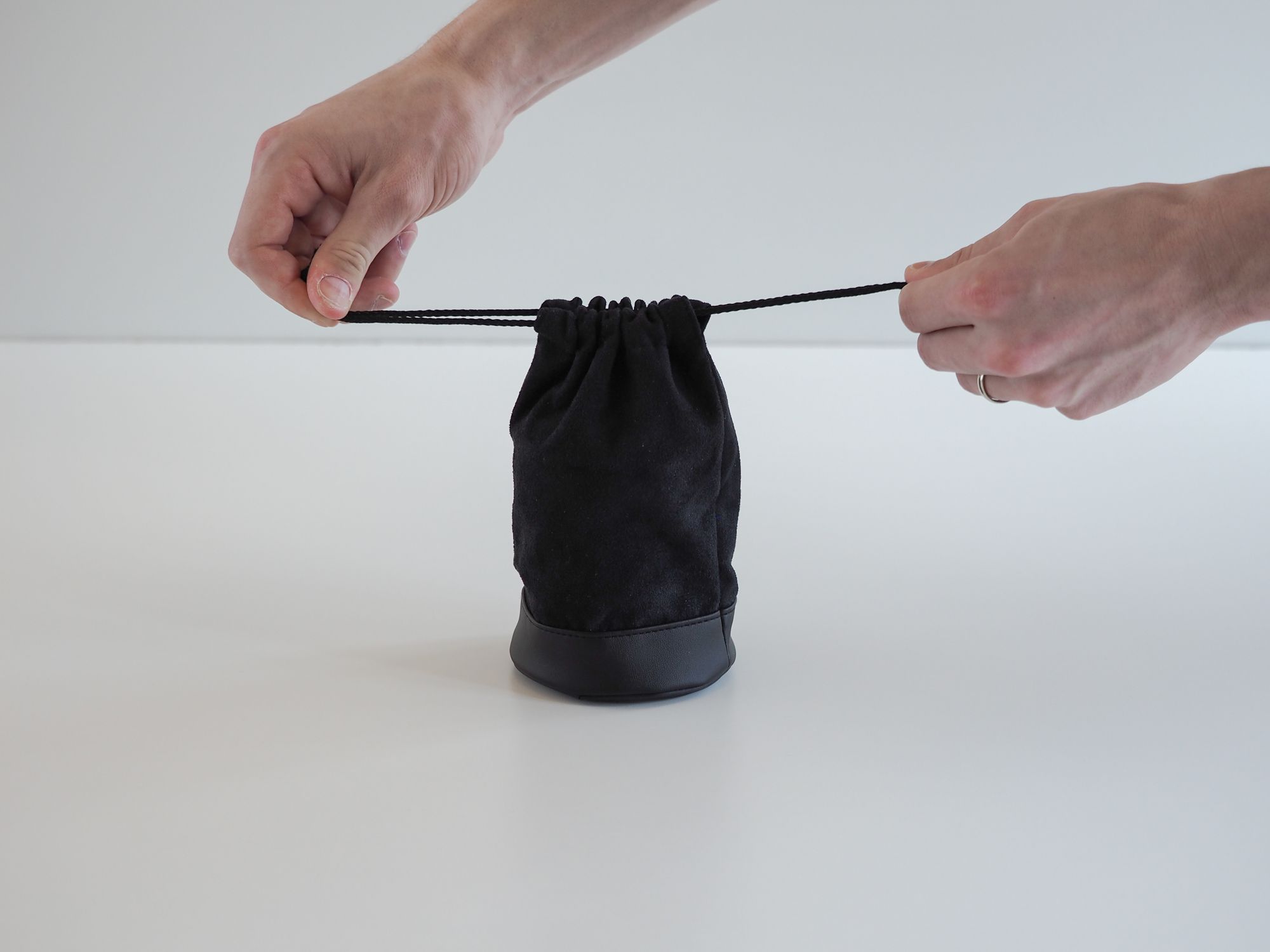
The carrying bag is closed by a draw string and fits the 12-40mm lens perfectly.
And finally, Olympus includes a supple carrying bag for those times when the lens isn’t attached to your camera. The bag fits the lens perfectly and is closed by a drawstring. The bottom of the bag is fitted with a synthetic leather, eliminating possible dirt stains if you pull the bag out outside.
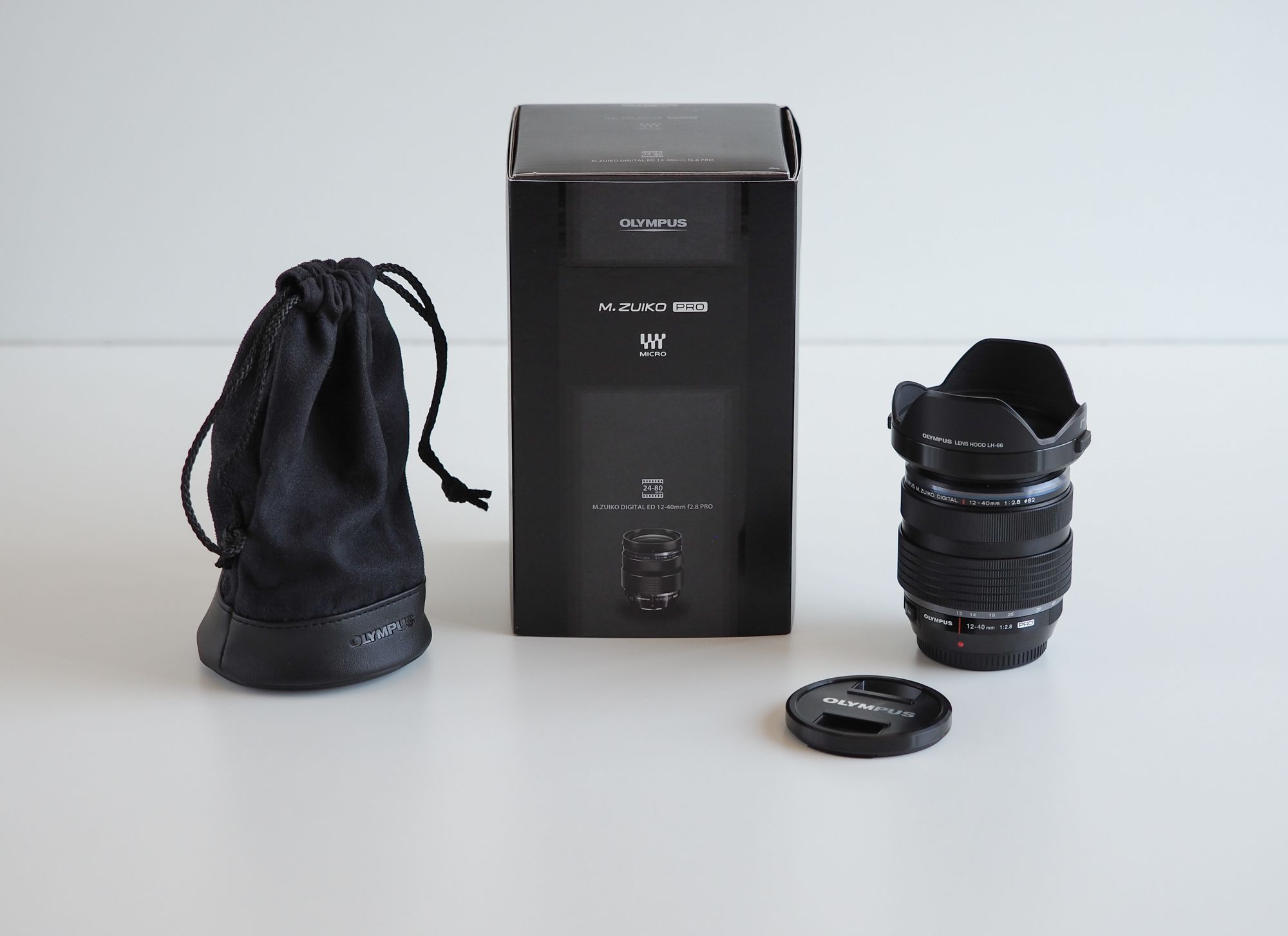
These accessories aren’t truly worth noting if they don’t sum up to something worthwhile. But as a whole, the accessories reflect Olympus’ care and precision in crafting this entire lens package. The lens itself is made of the highest quality, and you can feel this quality the moment you pick the lens up out of the box.
Free Photography Guide: Download our Better than iPhone Photography guide to help you get started with you photo skills and camera basics. Along with our gear recommendations for getting started. Get it here.
Autofocus
Olympus is known for its lightning fast autofocus system, and the 12-40mm f/2.8 Pro certainly doesn’t disappoint. The lens has a movie and still compatible autofocus lens drive to provide fast and quiet autofocusing. This ability is lost on me, but is essential for videographers who want to capture proper sound and not the lens’ autofocus whir.

Photo taken with the Olympus OM-D E-M10 and Olympus 12-40mm f/2.8 Pro at 40mm, ISO 200, f/2.8, and 1/800 sec.
In usage, the 12-40mm’s autofocus lives up to the hype. When shooting many of the images in this review, my friend Josiah immediately noted how fast the lens snapped from one focus point to another. I’ve often found very little need to apply continuous autofocus settings when shooting because of how fast the lens can focus from one spot to the next. If this lens is used as an everyday lens to take photos of the movement of everyday life, the lens’ autofocus system won’t let you down.
Image Quality
At the end of the day, if the compromise of a zoom lens’ image quality is too great for the added benefit of zooming across a range of focal lengths, many shooters will stick to high quality prime lenses and use their feet to zoom across those focal ranges instead. After using the 12-40mm f/2.8 Pro for a few months, I can genuinely say I made the right decision to abandon prime lenses in favour of the zoom lens flexibility.
However, I won’t ever say I won’t purchase a prime lens in the future. Without a doubt, prime lenses offer higher quality images than their zoom counterparts, and the 12-40mm isn’t an outlier. Certain aspects of this lens are better than prime lenses I have tried, while other aspects still take a knee to prime lenses.
Sharpness
There’s no doubt in my mind the Olympus 12-40mm f/2.8 Pro offers some of the sharpest images on the planet. When focused on the right spot, the lens offers sharpness you have to see on a high resolution display to believe.

Photo taken with the Olympus OM-D E-M10 and Olympus 12-40mm f/2.8 Pro at 40mm, ISO 200, f/2.8, and 1/800 sec.
Right from f/2.8, the 12-40mm is sharp throughout the image. From corner to corner, the 12-40mm captures detail beautifully. Luckily, it’s sharpest at f/2.8, so you can shoot wide open and give yourself the fastest shutter speeds possible and not have to worry about blurred edges of your subject.

Photo taken with the Olympus OM-D E-M10 and Olympus 12-40mm f/2.8 Pro at 12mm, ISO 200, f/2.8 and 1/4000 sec.

Photo taken with the Olympus OM-D E-M10 and Olympus 12-40mm f/2.8 Pro at 40mm, ISO 200, f/2.8 and 1/2500 sec.
Sharpness also doesn’t drop off at any point in the focal range. Images are sharp at 12mm right through to 40mm. If you choose to shoot wide open at 12mm, or stop down to f/5.6 and zoom to 40mm, you can be sure the image will be tack sharp from edge to edge.
Bokeh
This is the biggest drawback of the 12-40mm f/2.8 Pro, but it may be more indicative of the Micro 4/3 system as a whole. The Micro 4/3 sensor size renders images at a full-frame equivalent of 2x, meaning a 12-40mm focal length is actually a 24-80mm full-frame equivalent focal length. Same goes for depth of field — Micro 4/3 sensors render f/2.8 depth of field as though it were f/5.6 on a full-frame sensor.
This crop factor plays a large role in the bokeh department of the 12-40mm. Of course, subject isolation is not only possible, it’s stunning when done correctly. However, achieving the dreamy backgrounds found in the images shot by Josiah’s Canon 5D Mark II and 85mm f/1.8 lens is very difficult to do with the 12-40mm f/2.8 Pro. The 12-40mm never produces hazy bokeh, but you have to be aware of your subject’s backdrop before firing.

Photo taken with the Olympus OM-D E-M10 and Olympus 12-40mm f/2.8 Pro at 40mm, ISO 200, f/2.8 and 1/400 sec.
Take, for example, this image of my wife. The subject is super sharp (and easy to look at, if you don’t mind me adding), but the bare tree branches in the background are distracting. Clearly, subject isolation is possible, but blurring those distracting tree branches isn’t as easy as one would like.
Distractiveness aside, the 12-40mm’s bokeh is still very smooth and creamy. As we will see in the image samples, bokeh is still smooth and creamy when done right. So much of background blur is in the distance from your subject, or how far your subject is from the details in the background. The distracting background above is just as indicative of the placement of the subject as it is of the sensor and f/2.8 lens combination.
Image Samples
As I move through the photography world and learn as much as I can, I’ve found myself losing respect for all pixel peeping pleasures and the technical jargon we get caught up in. Images today can be corrected ten times over in post-processing software and any issues with the image out of the camera are not worth worrying about. Color fringing, chromatic aberrations, and barrel distortion can all be fixed quickly with software, so I find myself worrying more these days about a lens’ ergonomics, build quality, and handling.
However, with that said, extra images are a must in an extensive lens review. Sometimes sample images show glaring weaknesses instead of the lens’ true strengths. Luckily, I’ll let the image samples speak to the strength of the 12-40mm f/2.8 Pro lens.

Photo taken with the Olympus OM-D E-M10 and Olympus 12-40mm f/2.8 Pro at 12mm, ISO 200, f/2.8 and 1/2500 sec. with a circular polarizer.

Photo taken with the Olympus OM-D E-M10 and Olympus 12-40mm f/2.8 Pro at 40mm, ISO 200, f/2.8 and 1/2000 sec. with a circular polarizer.

Photo taken with the Olympus OM-D E-M10 and Olympus 12-40mm f/2.8 Pro at 40mm, ISO 200, f/2.8 and 1/250 sec.

Photo taken with the Olympus OM-D E-M10 and Olympus 12-40mm f/2.8 Pro at 17mm, ISO 200, f/2.8 and 1/1600 sec. with a circular polarizer.

Photo taken with the Olympus OM-D E-M10 and Olympus 12-40mm f/2.8 Pro at 40mm, ISO 200, f/2.8 and 1/640 sec.

Photo taken with the Olympus OM-D E-M10 and Olympus 12-40mm f/2.8 Pro at 17mm, ISO 200, f/2.8 and 1/1600 sec. with a circular polarizer.

Photo taken with the Olympus OM-D E-M10 and Olympus 12-40mm f/2.8 Pro at 12mm, ISO 200, f/2.8 and 1/1250 sec.

Photo taken with the Olympus OM-D E-M10 and Olympus 12-40mm f/2.8 Pro at 35mm, ISO 200, f/2.8 and 1/4000 sec.
Conclusion
From the onset, the Micro 4/3 system is best known for its small, compact, and light camera bodies and lenses. This is why I became a Micro 4/3 owner to begin with. I was tired of lugging a DSLR and travel zoom on trips, so I opted for the small Olympus OM-D E-M10 and the Panasonic Lumix 20mm pancake lens.
Since my initial purchase, my needs and wants have changed. Fortunately for me, that doesn’t mean I need to substantially increase the size of my kit. The 12-40mm f/2.8 Pro lens from Olympus is a fair-sized lens in the Micro 4/3 world, but it doesn’t undermine the principles of the system as a whole.
I started this review with a small discussion about the compromises of zoom lenses. Prime lenses are optimised for one specific focal length and they perform admirably at that one focal length. In contrast, zooms need to make small compromises to include the option of shooting at different focal lengths.
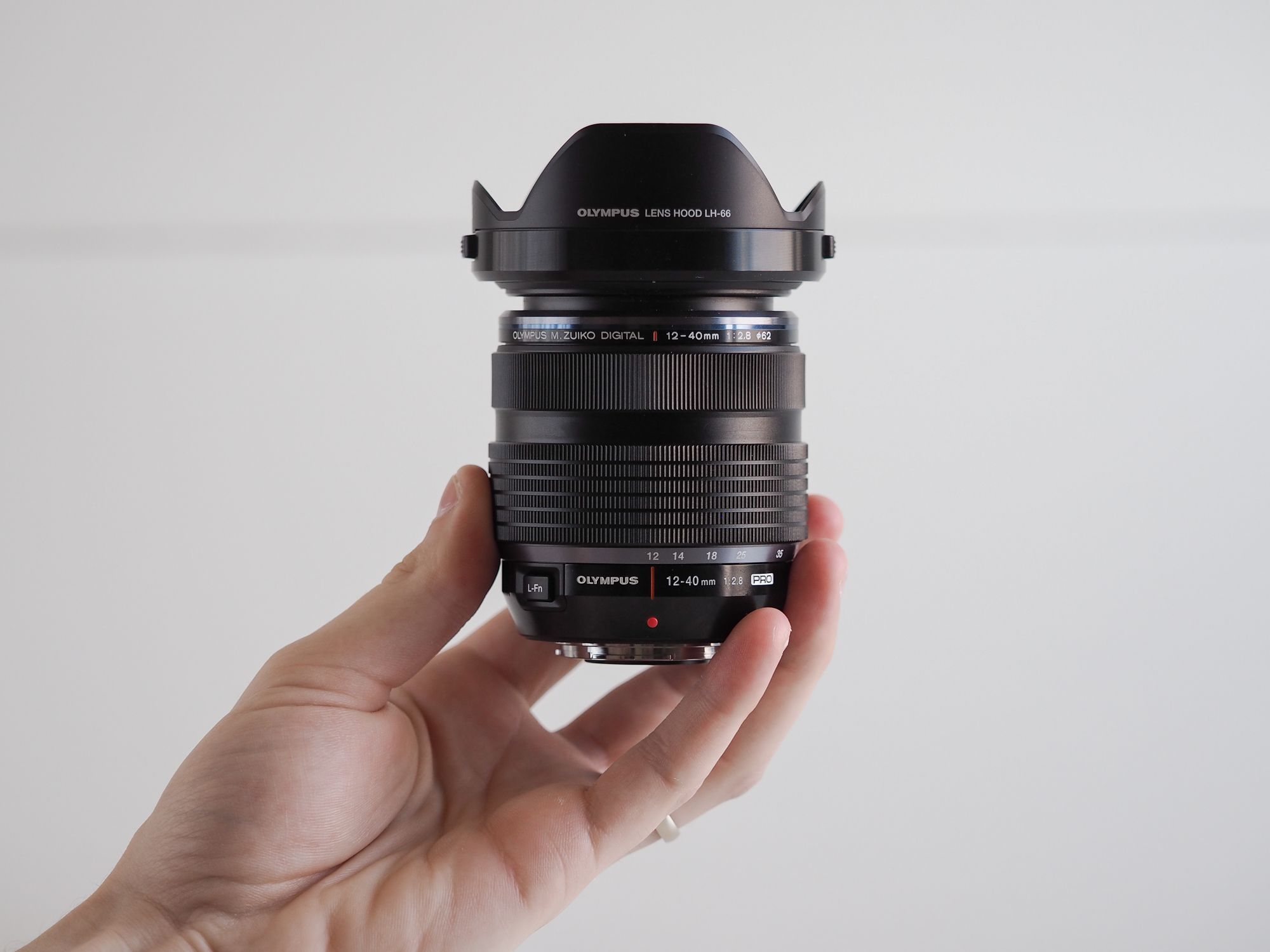
Yet, somehow, the Olympus 12-40mm f/2.8 Pro makes next to no compromises at all. From build quality, to image quality, to ergnomics and handling, this lens is the most uncompromising lens I could have hoped for. I prepared myself mentally to be let down in numerous aspects of the lens, but every time I turn my head, I’m continually surprised with the results.
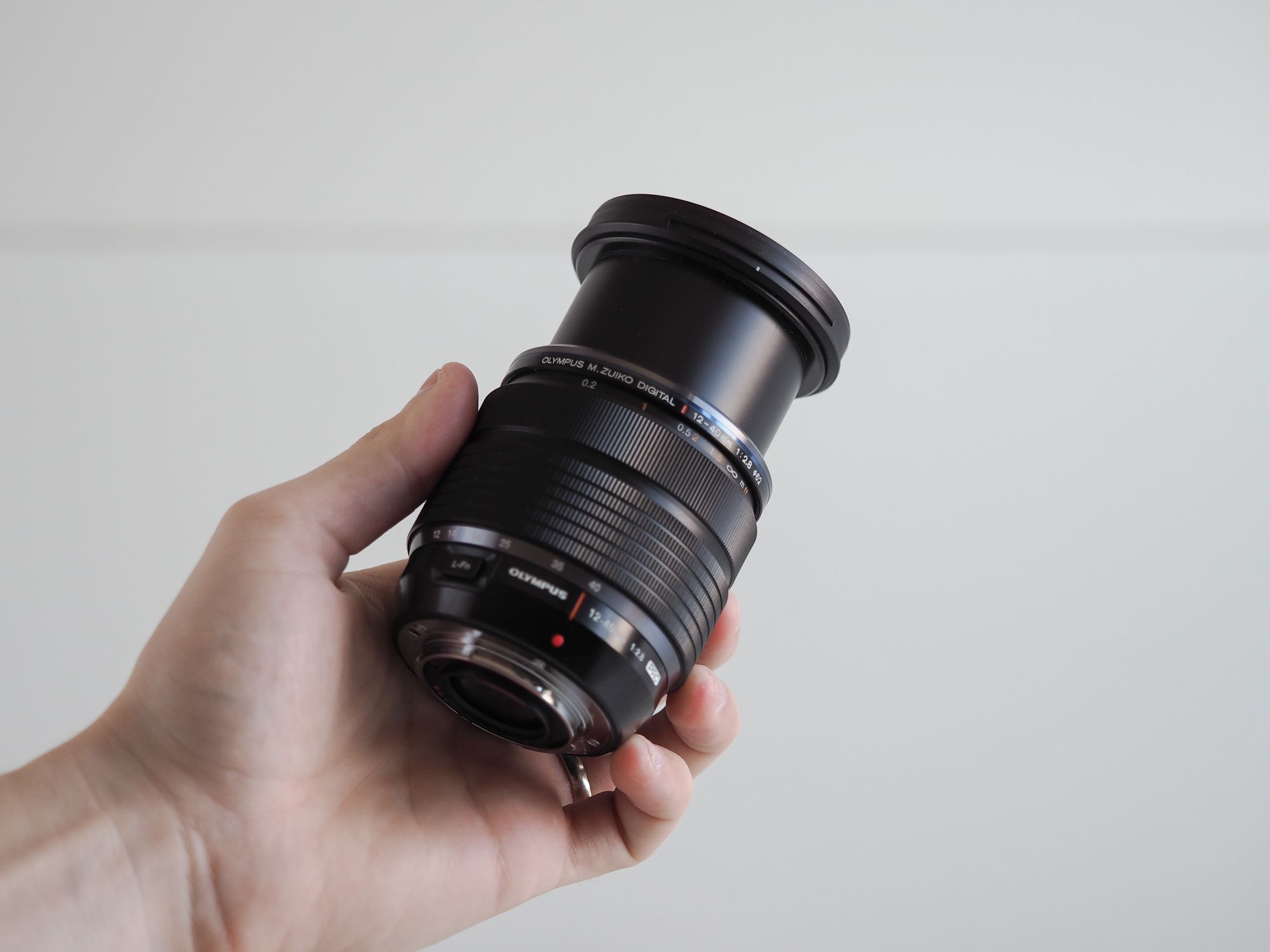
Sure, there are some compromises which can’t be overcome. The Micro 4/3 sensor physically can not produce the same depth of field as a full-frame sensor, and this can rear its head when shooting portraits with unfriendly backgrounds. Physics are physics.
But that really is the limit to the 12-40mm f/2.8 Pro’s compromises. This lens is fit and finished with professionals and enthusiasts in mind. And it delivers. It would be my absolute favourite lens if I hadn’t already picked it up its big sister, the 40-150mm f/2.8 Pro.
Eliminating those compromises does come at a cost, especially if you consider costs in relation to the rest of the Micro 4/3 system. This lens runs a cost of $999 (currently on sale for $899!), which is fairly steep in relation to the less expensive primes in the system. But if the 12-40mm’s cost is considered in relation to other professional zooms in other systems — say, Nikon’s Nikkor 24-70mm f/2.8G — the 12-40mm is extremely inexpensive considering all its benefits. Every possible lens benefit is here, and all for half the cost (and half the size) of a competing lens in the full-frame variety. Considering that, I feel $999 is actually quite reasonable.

Overall, the Olympus 12-40mm f/2.8 Pro is a fantastic everyday zoom lens which has superb image quality and a plethora of high quality features to boot.
I wanted a zoom lens which could stay on my E-M10 for 90% of the day and would produce almost the same image quality as the prime lenses I sold to purchase it. I also wanted to make the least amount of compromises possible in the process. Not only did I find a lens which checked all the boxes on my list, I found a lens with a classy personality and high profile characteristics. Between this lens and the larger 40-150mm f/2.8 Pro, I am covered for 95% of the focal lengths I’ll ever need.
I have become a zoom guy. I said it. Now excuse me while I head outside to capture the last few rays of this beautiful sunset.
Free Photography Guide: Download our Better than iPhone Photography guide to help you get started with you photo skills and camera basics. Along with our gear recommendations for getting started. Get it here.